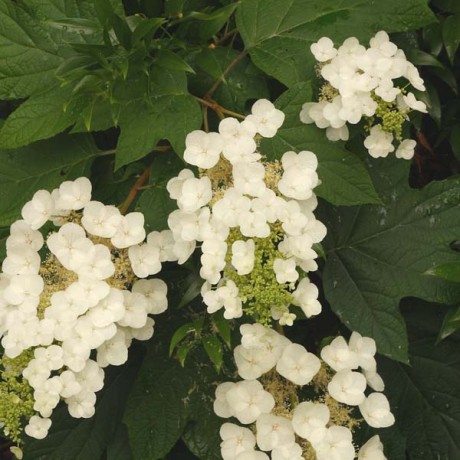Ode to the oakleaf
A showy hydrangea plus March gardening tips
By L.A. JacksonThe oakleaf hydrangea is as advertised — and more. This Southeast native is named for the fact that its deeply lobed leaves resemble those of an oak. Even its botanical name gives away the similarity: Hydrangea quercifolia, with "querci" being the Latin derivative for "oak" and "folia" meaning "leaf."
This medium-size, deciduous shrub grows (depending on the cultivar) 4 to 8 feet tall and up to 12 feet wide. It shows off tapering panicles of white to cream-colored flowers that range from 4 to 12 inches long and 3 to 4 inches wide. Quite showy, to say the least! The blooms fade to light rose and then a soft brown. The blossoms also persist on the stems, making them ideal material for dried arrangements.
Oakleaf hydrangeas bloom on old wood formed the previous season, so if any pruning is necessary, do it right after the flowers begin to fade.
And as impressive as this hydrangea's flowers can be, just wait until fall! That's when its distinct leaves put on their own show by turning stunning shades of bronze, burgundy and purple.
Oakleaf hydrangea prefers a well-draining site that gets early sun and a bit of afternoon shade. This is an ideal placement because the blooms will last longer with some late shade, while the morning sunshine will help brighten this hydrangea's fall foliage colors.
As with many native plants of note, there are cultivated spin-offs from the species. 'Alice' is one of the more popular commercial selections because of its long (up to 12 inches) panicles and outstanding autumn colors. Also consider 'Snowflake', which has multiple sepals that pile on top of older ones, creating a double-flower look. And if garden space is at a premium, 'Pee Wee' is your kind of oakleaf because it only stretches to about 4 feet tall and wide. 'Little Honey' is another 4-foot shortie, and its bright chartreuse leaves really make it stand out.
Garden To Do's
March
- Annual vegetable and flower beds should be rejuvenated by being tilled. While the dirt is being turned over, mix in liberal amounts of compost, leaf mold or other decayed organic matter to help improve the tilth and add natural nutrients into the soil.
- Summer beauties such as althea, buddleia, vitex, crepe myrtle and pomegranate can be pruned at the beginning of March to stimulate more flower production later in the growing season.
- Easy on the pruners! Not all trees and shrubs benefit from a spring shearing. Wait to snip early-blooming beauties such as azalea, camellia (Camellia japonica), Carolina jessamine, forsythia, flowering quince, spirea, viburnum, mock orange, weigela and Oriental magnolia until after their flowers have faded.
- Keep fallen Camellia japonica blooms raked up to help prevent camellia petal blight, which is caused by a soil-borne fungus that thrives on the spent flowers.
- Cool-season veggies such as cabbage, leaf lettuce, mustard greens, radishes, spinach, turnips, onions, potatoes and kale can be started any time this month, weather permitting. Also, beets, broccoli, cauliflower and Chinese cabbage can be planted by the third to fourth week of this month.
- Migratory birds should be returning soon, so welcome them back by cleaning old nests and debris out of bird houses and giving the bird bath a good scrubbing.
-
Share this story:



